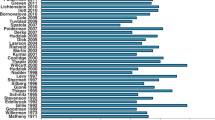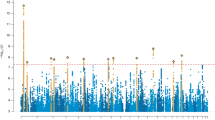Abstract
Attention-deficit/hyperactivity disorder (ADHD) is among the most common childhood-onset psychiatric disorders. Although family, twin, and adoption studies demonstrate that ADHD is a highly heritable condition, studies also suggest that genetic architecture is complex, prompting the use of more advanced methodologies such as genome-wide linkage and association studies. Although such studies are theoretically compelling, replication of these results has been inconsistent. Meta-analyses have produced more reliable results, but the associations identified to date account for only a small percentage of the genetic component of ADHD. Approaches such as neuroimaging genetics and epigenetic studies are being explored to probe further the etiologic complexity of this disorder.
Similar content being viewed by others
References and Recommended Reading
Polanczyk G, de Lima MS, Horta BL, et al.: The worldwide prevalence of ADHD: a systematic review and metaregression analysis. Am J Psychiatry 2007, 164:942–948.
Leibson CL, Katusic SK, Barbaresi WJ, et al.: Use and costs of medical care for children and adolescents with and without attention-deficit/hyperactivity disorder. JAMA 2001, 285:60–66.
Faraone SV, Sergeant J, Gillberg C, et al.: The worldwide prevalence of ADHD: is it an American condition? World Psychiatry 2003, 2:104–113.
Harpin VA: The effect of ADHD on the life of an individual, their family, and community from preschool to adult life. Arch Dis Child 2005, 90(Suppl 1):i2–i7.
Faraone SV, Doyle AE: Genetic influences on attention deficit hyperactivity disorder. Curr Psychiatry Rep 2000, 2:143–146.
Sprich S, Biederman J, Crawford MH, et al.: Adoptive and biological families of children and adolescents with ADHD. J Am Acad Child Adolesc Psychiatry 2000, 39:1432–1437.
Satterfield JH, Cantwell DP, Satterfield BT: Pathophysiology of the hyperactive child syndrome. Arch Gen Psychiatry 1974, 31:839–844.
Faraone SV, Perlis RH, Doyle AE, et al.: Molecular genetics of attention-deficit/hyperactivity disorder. Biol Psychiatry 2005, 57:1313–1323.
Hebebrand J, Dempfle A, Saar K, et al.: A genome-wide scan for attention-deficit/hyperactivity disorder in 155 German sib-pairs. Mol Psychiatry 2006, 11:196–205.
Ogdie MN, Bakker SC, Fisher SE, et al.: Pooled genomewide linkage data on 424 ADHD ASPs suggests genetic heterogeneity and a common risk locus at 5p13. Mol Psychiatry 2006, 11:5–8.
Ogdie MN, Macphie IL, Minassian SL, et al.: A genomewide scan for attention-deficit/hyperactivity disorder in an extended sample: suggestive linkage on 17p11. Am J Hum Genet 2003, 72:1268–1279.
Arcos-Burgos M, Castellanos FX, Pineda D, et al.: Attention-deficit/hyperactivity disorder in a population isolate: linkage to loci at 4q13.2, 5q33.3, 11q22, and 17p11. Am J Hum Genet 2004, 75:998–1014.
Fisher SE, Francks C, McCracken JT, et al.: A genomewide scan for loci involved in attention-deficit/hyperactivity disorder. Am J Hum Genet 2002, 70:1183–1196.
Bakker SC, van der Meulen EM, Buitelaar JK, et al.: A whole-genome scan in 164 Dutch sib pairs with attention-deficit/hyperactivity disorder: suggestive evidence for linkage on chromosomes 7p and 15q. Am J Hum Genet 2003, 72:1251–1260.
Asherson P, Zhou K, Anney RJ, et al.: A high-density SNP linkage scan with 142 combined subtype ADHD sib pairs identifies linkage regions on chromosomes 9 and 16. Mol Psychiatry 2008, 13:514–521.
Zhou K, Asherson P, Sham P, et al.: Linkage to chromosome 1p36 for attention-deficit/hyperactivity disorder traits in school and home settings. Biol Psychiatry 2008, 64:571–576.
Romanos M, Freitag C, Jacob C, et al.: Genome-wide linkage analysis of ADHD using high-density SNP arrays: novel loci at 5q13.1 and 14q12. Mol Psychiatry 2008, 13:522–530.
Faraone SV, Doyle AE, Lasky-Su J, et al.: Linkage analysis of attention deficit hyperactivity disorder. Am J Med Genet B Neuropsychiatr Genet 2008, 147B:1387–1391.
Zhou K, Dempfle A, Arcos-Burgos M, et al.: Meta-analysis of genome-wide linkage scans of attention deficit hyperactivity disorder. Am J Med Genet B Neuropsychiatr Genet 2008, 147B:1392–1398.
Rommelse NN, Arias-Vasquez A, Altink ME, et al.: Neuropsychological endophenotype approach to genome-wide linkage analysis identifies susceptibility loci for ADHD on 2q21.1 and 13q12.11. Am J Hum Genet 2008, 83:99–105.
Doyle AE, Ferreira MA, Sklar PB, et al.: Multivariate genomewide linkage scan of neurocognitive traits and ADHD symptoms: suggestive linkage to 3q13. Am J Med Genet B Neuropsychiatr Genet 2008, 147B:1399–1411.
Mick E, Faraone SV: Genetics of attention deficit hyperactivity disorder. Child Adolesc Psychiatr Clin N Am 2008, 17:261–284, vii–viii.
Albayrak O, Friedel S, Schimmelmann BG, et al.: Genetic aspects in attention-deficit/hyperactivity disorder. J Neural Transm 2008, 115:305–315.
Sunohara GA, Roberts W, Malone M, et al.: Linkage of the dopamine D4 receptor gene and attention-deficit/hyperactivity disorder. J Am Acad Child Adolesc Psychiatry 2000, 39:1537–1542.
Langley K, Fowler TA, Grady DL, et al.: Molecular genetic contribution to the developmental course of attention-deficit hyperactivity disorder. Eur Child Adolesc Psychiatry 2009, 18:26–32.
Laucht M, Skowronek MH, Becker K, et al.: Interacting effects of the dopamine transporter gene and psychosocial adversity on attention-deficit/hyperactivity disorder symptoms among 15-year-olds from a high-risk community sample. Arch Gen Psychiatry 2007, 64:585–590.
Lesch KP, Bengel D, Heils A, et al.: Association of anxiety-related traits with a polymorphism in the serotonin transporter gene regulatory region. Science 1996, 274:1527–1531.
Retz W, Freitag CM, Retz-Junginger P, et al.: A functional serotonin transporter promoter gene polymorphism increases ADHD symptoms in delinquents: interaction with adverse childhood environment. Psychiatry Res 2008, 158:123–131.
Biederman J, Kim JW, Doyle AE, et al.: Sexually dimorphic effects of four genes (COMT, SLC6A2, MAOA, SLC6A4) in genetic associations of ADHD: a preliminary study. Am J Med Genet B Neuropsychiatr Genet 2008, 147B:1511–1518.
Brookes K, Xu X, Chen W, et al.: The analysis of 51 genes in DSM-IV combined type attention deficit hyperactivity disorder: association signals in DRD4, DAT1 and 16 other genes. Mol Psychiatry 2006, 11:934–953.
Kim JW, Biederman J, McGrath CL, et al.: Further evidence of association between two NET single-nucleotide polymorphisms with ADHD. Mol Psychiatry 2008, 13:624–630.
Li D, Sham PC, Owen MJ, et al.: Meta-analysis shows significant association between dopamine system genes and attention deficit hyperactivity disorder (ADHD). Hum Mol Genet 2006, 15:2276–2284.
Lowe N, Kirley A, Hawi Z, et al.: Joint analysis of the DRD5 marker concludes association with attention-deficit/hyperactivity disorder confined to the predominantly inattentive and combined subtypes. Am J Hum Genet 2004, 74:348–356.
Maher BS, Marazita ML, Ferrell RE, et al.: Dopamine system genes and attention deficit hyperactivity disorder: a meta-analysis. Psychiatr Genet 2002, 12:207–215.
Purper-Ouakil D, Wohl M, Mouren MC, et al.: Metaanalysis of family-based association studies between the dopamine transporter gene and attention deficit hyperactivity disorder. Psychiatr Genet 2005, 15:53–59.
Yang B, Chan RC, Jing J, et al.: A meta-analysis of association studies between the 10-repeat allele of a VNTR polymorphism in the 3’-UTR of dopamine transporter gene and attention deficit hyperactivity disorder. Am J Med Genet B Neuropsychiatr Genet 2007, 144:541–550.
Cheuk DK, Wong V: Meta-analysis of association between a catechol-O-methyltransferase gene polymorphism and attention deficit hyperactivity disorder. Behav Genet 2006, 36:651–659.
Kuntsi J, Neale BM, Chen W, et al.: The IMAGE project: methodological issues for the molecular genetic analysis of ADHD. Behav Brain Funct 2006, 2:27.
Neale BM, Lasky-Su J, Anney R, et al.: Genome-wide association scan of attention deficit hyperactivity disorder. Am J Med Genet B Neuropsychiatr Genet 2008, 147B:1337–1344.
Lasky-Su J, Anney RJ, Neale BM, et al.: Genome-wide association scan of the time to onset of attention deficit hyperactivity disorder. Am J Med Genet B Neuropsychiatr Genet 2008, 147B:1355–1358.
Durston S, Fossella JA, Casey BJ, et al.: Differential effects of DRD4 and DAT1 genotype on fronto-striatal gray matter volumes in a sample of subjects with attention deficit hyperactivity disorder, their unaffected siblings, and controls. Mol Psychiatry 2005, 10:678–685.
Heiser P, Heinzel-Gutenbrunner M, Frey J, et al.: Twin study on heritability of activity, attention, and impulsivity as assessed by objective measures. J Atten Disord 2006, 9:575–581.
Groot AS, de Sonneville LM, Stins JF, et al.: Familial influences on sustained attention and inhibition in preschoolers. J Child Psychol Psychiatry 2004, 45:306–314.
Johnson KA, Robertson IH, Kelly SP, et al.: Dissociation in performance of children with ADHD and high-functioning autism on a task of sustained attention. Neuropsychologia 2007, 45:2234–2245.
Bellgrove MA, Hawi Z, Kirley A, et al.: Association between dopamine transporter (DAT1) genotype, left-sided inattention, and an enhanced response to methylphenidate in attention-deficit hyperactivity disorder. Neuropsychopharmacology 2005, 30:2290–2297.
Bellgrove MA, Hawi Z, Kirley A, et al.: Dissecting the attention deficit hyperactivity disorder (ADHD) phenotype: sustained attention, response variability and spatial attentional asymmetries in relation to dopamine transporter (DAT1) genotype. Neuropsychologia 2005, 43:1847–1857.
Kieling C, Roman T, Doyle AE, et al.: Association between DRD4 gene and performance of children with ADHD in a test of sustained attention. Biol Psychiatry 2006, 60:1163–1165.
Bellgrove MA, Domschke K, Hawi Z, et al.: The methionine allele of the COMT polymorphism impairs prefrontal cognition in children and adolescents with ADHD. Exp Brain Res 2005, 163:352–360.
Aron AR, Poldrack RA: The cognitive neuroscience of response inhibition: relevance for genetic research in attention-deficit/hyperactivity disorder. Biol Psychiatry 2005, 57:1285–1292.
Langley K, Marshall L, van den Bree M, et al.: Association of the dopamine D4 receptor gene 7-repeat allele with neuropsychological test performance of children with ADHD. Am J Psychiatry 2004, 161:133–138.
Cornish KM, Manly T, Savage R, et al.: Association of the dopamine transporter (DAT1) 10/10-repeat genotype with ADHD symptoms and response inhibition in a general population sample. Mol Psychiatry 2005, 10:686–698.
Linnet KM, Dalsgaard S, Obel C, et al.: Maternal lifestyle factors in pregnancy risk of attention deficit hyperactivity disorder and associated behaviors: review of the current evidence. Am J Psychiatry 2003, 160:1028–1040.
Mick E, Biederman J, Faraone SV, et al.: Case-control study of attention-deficit hyperactivity disorder and maternal smoking, alcohol use, and drug use during pregnancy. J Am Acad Child Adolesc Psychiatry 2002, 41:378–385.
Accornero VH, Amado AJ, Morrow CE, et al.: Impact of prenatal cocaine exposure on attention and response inhibition as assessed by continuous performance tests. J Dev Behav Pediatr 2007, 28:195–205.
Walker DW, Curtis B, Lacey B, et al.: Kynurenic acid in brain and cerebrospinal fluid of fetal, newborn, and adult sheep and effects of placental embolization. Pediatr Res 1999, 45:820–826.
O’Connor TG, Heron J, Golding J, et al.: Maternal antenatal anxiety and children’s behavioural/emotional problems at 4 years. Report from the Avon Longitudinal Study of Parents and Children. Br J Psychiatry 2002, 180:502–508.
Meaney MJ, Szyf M, Seckl JR: Epigenetic mechanisms of perinatal programming of hypothalamic-pituitary-adrenal function and health. Trends Mol Med 2007, 13:269–277.
Yokomori N, Moore R, Negishi M: Sexually dimorphic DNA demethylation in the promoter of the Slp (sex-limited protein) gene in mouse liver. Proc Natl Acad Sci U S A 1995, 92:1302–1306.
Hultman CM, Torrang A, Tuvblad C, et al.: Birth weight and attention-deficit/hyperactivity symptoms in childhood and early adolescence: a prospective Swedish twin study. J Am Acad Child Adolesc Psychiatry 2007, 46:370–377.
Author information
Authors and Affiliations
Corresponding author
Rights and permissions
About this article
Cite this article
Smith, A.K., Mick, E. & Faraone, S.V. Advances in genetic studies of attention-deficit/hyperactivity disorder. Curr Psychiatry Rep 11, 143–148 (2009). https://doi.org/10.1007/s11920-009-0022-0
Published:
Issue Date:
DOI: https://doi.org/10.1007/s11920-009-0022-0




